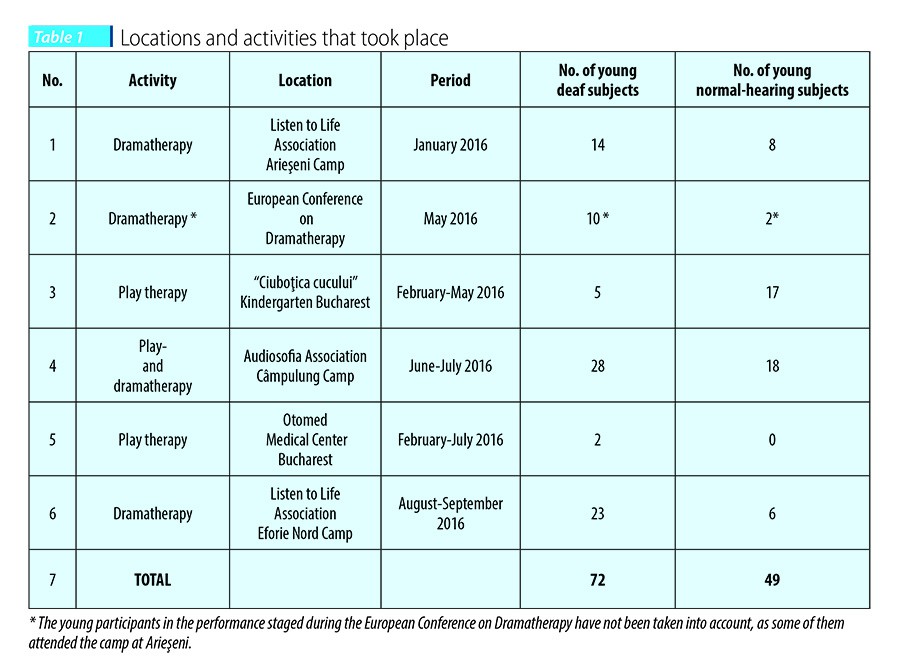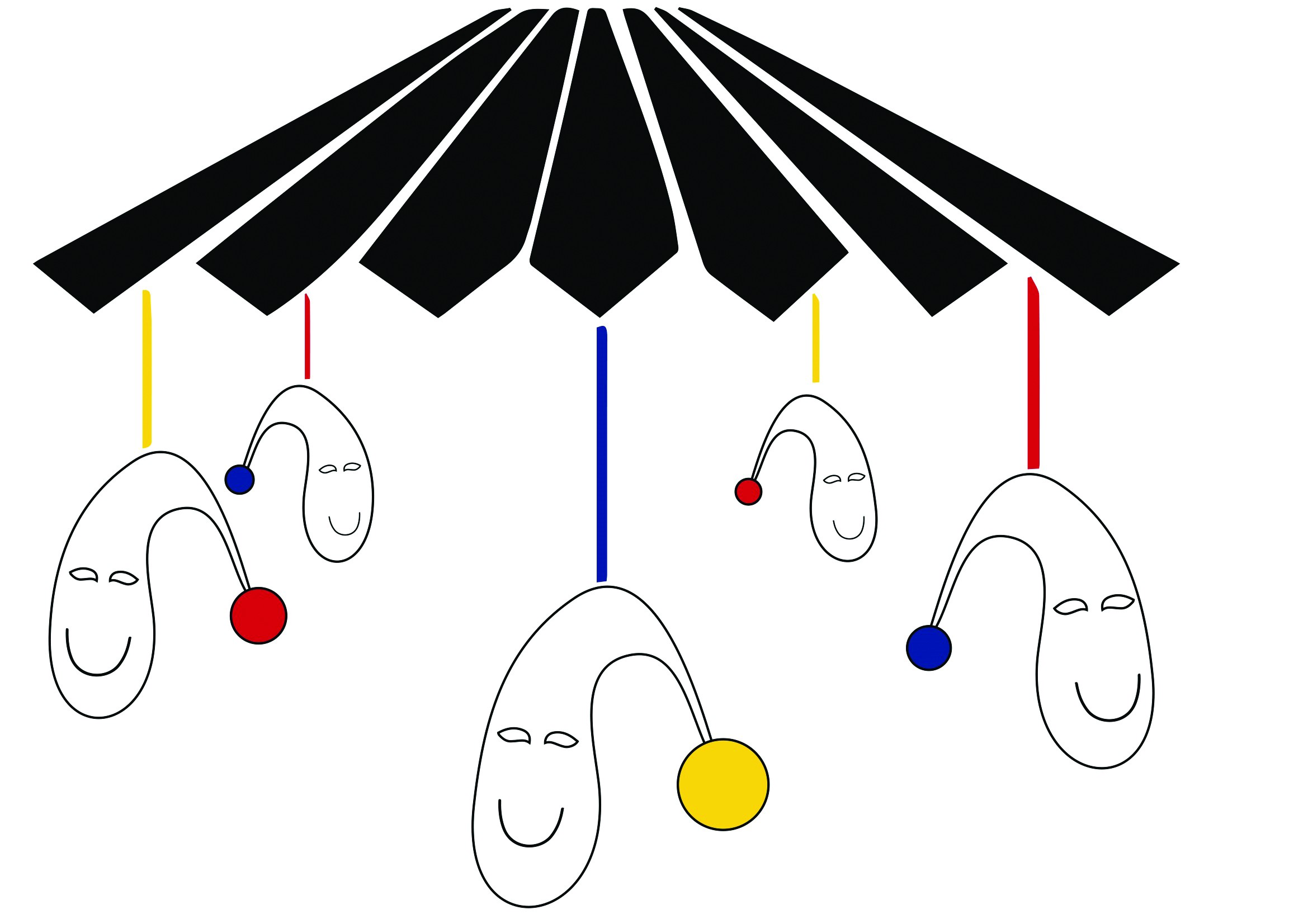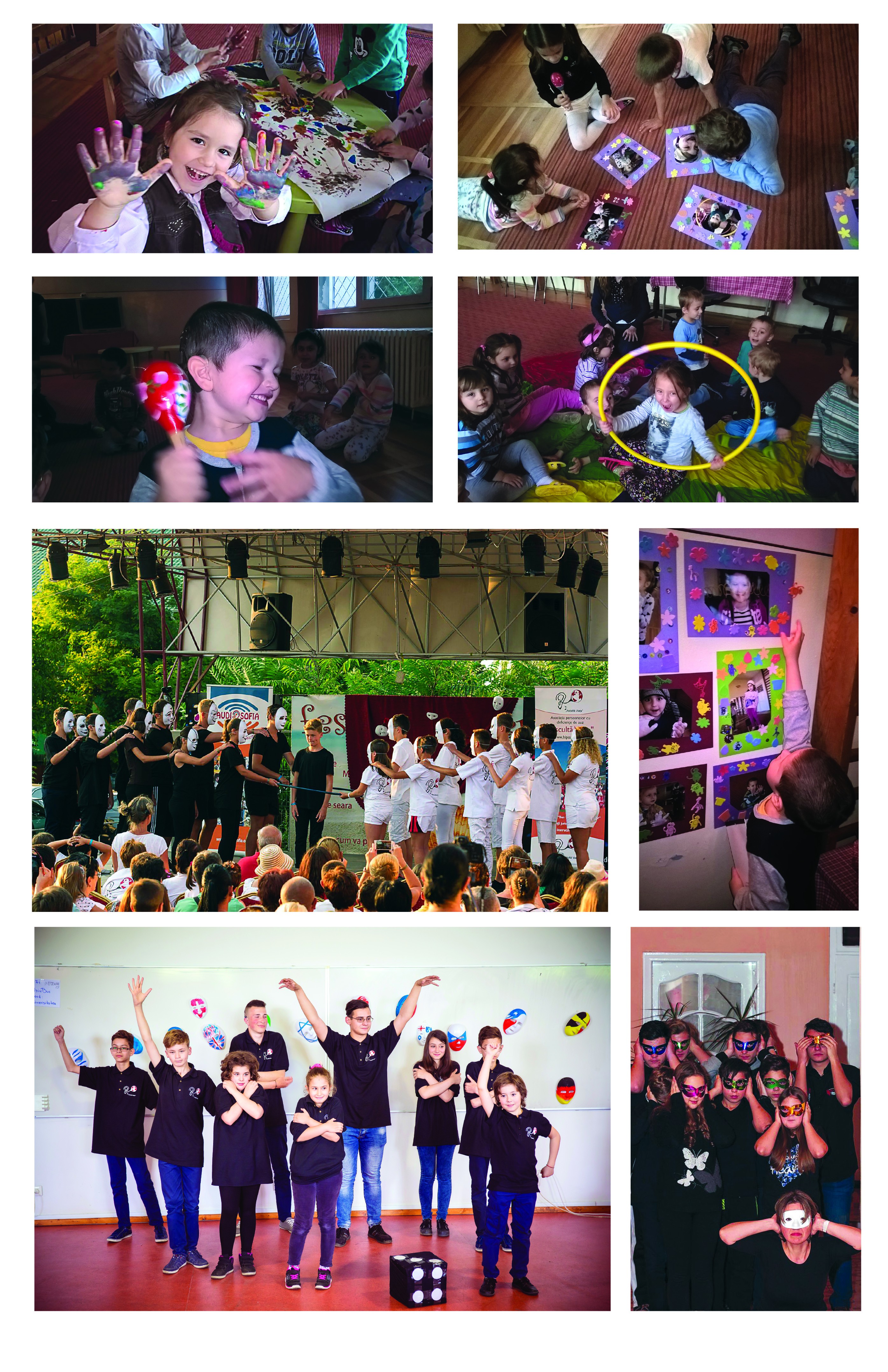The present interactive research-action-training project, looking at the young cochlear-implanted subjects from a multidisciplinary holistic perspective, was based on the theory on psychosocial development of human beings, the attachment theory, language development theories and the concept of resilience. The integrative approach suggests two creative therapeutic styles (play- and dramatherapy) as means of intervention of neuro-dramatic play. The study starts from the hypothesis that creative therapies will help young children wearing cochlear implants at social integration in the peer groups of normal-hearing children and teenagers. This integrative approach will facilitate developement of teamwork abilities by improving their self-esteem and self-image. We included children and their families in an assisted resilience process with expert paticipation in the field of social and political development of Romanian non-guvernamental organisations. Material and method. The research-action-training project targets 3-18-year-old deaf children and teenagers wearing cochlear implants or hearing aids. The study considered a group of 72 deaf children and teenagers, as well as 49 normal-hearing subjects of similar ages, who were observed during the whole therapeutic program. Specific techniques were: painting, drawing, modelling, sand, miniatures, sensorial and corporal plays, role play, improvisation, body movement, music, dance, mimic and masks. The professional teams (psychologists, dramatherapists, educators, medical assistants, students at the school of play- and dramatherapy, film directors) who worked with and supervised these children and teenagers during the whole project (whose coordinator was helped by 12 volunteers) assured a secured and relaxed atmosphere, observing rules which did not restrict young subjects’ freedom of expression. Results. The positive results show the necessity to implement creative therapies during the auditory-verbal rehabilitation of the young deaf subjects. 42% (of the young subjects) improved their body movements, 27% acquired better projection strategies, 67% ameliorated their ability of interpreting a role, and 72% got pro-risk scores. The results are accompanied by significant images shot during the program activities. Conclusions. Parallelling the audio-verbal therapy, the play- and dramatherapy are important complementary remedial treatments in stimulating the means of expression and communication of children and teenagers wearing cochlear implants.
Terapia prin joc și dramaterapia - tehnici complementare de reabilitare a copiilor cu implant cohlear
Play- and dramatherapy - complementary techniques for rehabilitation of children with cochlear implant
First published: 27 noiembrie 2016
Editorial Group: MEDICHUB MEDIA
DOI: 10.26416/Orl.33.4.2016.167
Abstract
Rezumat
Prezentarea proiectului de cercetare interactivă, acțiune și formare urmărește copiii și adolescenții purtători de implant cohlear dintr-o perspectivă holistică bazată pe teoria psihosocială a dezvoltării umane, teoria atașamentului, teoria dezvoltării limbajului și conceptul de reziliență. Abordarea integrativă propune două tipuri de terapii creative (terapia prin joc și dramaterapia) ca mijloace de intervenție bazate pe jocul neuro-dramatic. Studiul pornește de la ipoteza că terapiile creative ajută copiii și adolescenții purtatori de implant cohlear la integrarea socială în grupurile de copii și adolescenți cu auz normal de aceeași vârstă. Această abordare integrativă va facilita dezvoltarea abilităților de lucru în echipă prin creșterea stimei și imaginii de sine. Copiii și familiile lor au fost incluși într-un proces de reziliență asistată prin participarea experților din sfera socială și politică dezvoltând organizațiile nonguvernamentale din România. Material și metodă. Proiectul de cercetare-acțiune-formare urmărește un grup de copii și adolescenți purtători de implant cohlear sau de aparate auditive convenționale cu vârsta cuprinsă între 3 și 18 ani. Studiul s-a realizat pe baza lotului format din 72 de copii hipoacuzici și 49 cu auz normal cu vârste similare care au fost observați pe tot parcursul procesului terapeutic. Grupurile de terapie au fost mixte, fiind formate atât din copii hipoacuzici cât și din copii cu auz normal urmărind normalizarea copiilor hipoacuzici în grupurile celor de aceeași vârstă. Tehnicile specifice au fost: pictura, desenul, modelajul, jocul cu nisip, cu miniaturi, jocuri senzoriale și corporale, jocul de rol, improvizația, mișcarea corporală, muzica, dansul, mima și măștile. Echipele de profesioniști (psihologi, dramaterapeuți, educatori, asistenți medicali, studenți ai școlii de terapie prin joc și dramaterapie, regizori de film) care au lucrat cu acești copii și care i-au coordonat pe toată perioada derulării proiectiului (12 voluntari alături de coordonatoarea proiectului) au asigurat un mediu securizant și destins, cu reguli clare care trebuiau respectate fără a îngrădi libertatea de exprimare a copiilor. Rezultate. Rezultatele pozitive demonstrează necesitatea implementarii terapiilor creative în paralel cu reabilitarea auditiv-verbală a copiilor purtători de implant cohlear. 42% au avut o îmbunătatire a mișcărilor corporale, 27% au obținut strategii imbunătățite de proiecție, 67% și-au îmbunătățit abilitatea de a interpreta un rol, 72% dintre copii au obținut scoruri în favoarea riscului. Rezultatele sunt însoțite de imagini semnificative surprinse în timpul activităților terapeutice. Concluzii. În paralel cu terapia auditiv-verbală, terapia prin joc și dramaterapia reprezintă terapii complementare în stimularea modalităților de exprimare ale copiilor și adolescenților purtători de implant cohlear.
The methaphor of the “merry-go-round”
Hustle and bustle, agitation, all kind of noise, piebald colours and children voices… Attention! Attention! Something is going to take place! The curtain is lifted and a masks’ merry-go-round reveals behind. Here is a multicolour carousel, and the audience realizes it’s very special and even unprecedented. Why? Because everybody is aware that wonderful things are going to happen soon…
Wishing to get on the merry-go-round, a lot of children and teenagers are bunching up inquisitively toward the entrance gate. Still watching, the breathless parents give them the last advice before the long-expected travel. Some of the “passengers” have already travelled, for others it’s a new experience. Photos, hugs, emotions, tears of joy… The little ones are going to leave... What will happen there, how will they feel high up? Though some are afraid and others look like brave, all of them are eager to depart. The excitement increases, the magic develops and… unexpectedly, the merry-go-round starts turning round stunningly.
All of a sudden, all “passengers” feel they are getting wings, can detach from their parents and come through alone; they realize they will be able to regard the world from above, even fly and dream with eyes wide-open. They learn to laugh and cry together with the others. Shared stories, comic and tragic masks, various plays, balls, confetti, music and dance, jokes and multicolored dice invade them right and left. They know that, after getting up the merry-go-round, they will learn exciting news, make friends and, by rediscovering themselves, will wonder how many resources can each possess. Fear, anxiety of the unknown and any communication barrier will be surpassed. Time seems suspended, and the young passengers enjoy as much as they can the new experiences.
Though “Masks’ merry-go-round” has turned for months, everything seems to have finished at once. The carousel has suddenly stopped. The little ones descend, their faces are glowing and the eyes are sparkling of joy. Masks have already been thrown away: the youngsters have learnt what they really know, who they are in fact and what they are able to do. As for parents… Some seem still thunder-stricken, others are eager to learn the magic having happened high up, and the rest, willing to immediately squeeze their children, are feverishly waiting for them. Each child lives a story, each family has their story.
All of them feel happier and richer, and they will surely remember the secret they have discovered in the mask’s merry-go-round, where everything seems possible.
Introduction
“Masks’ Merry-go-round”, the third project the Audiosofia Association manages, is financed by the Community Foundation and MOL Romania. After the projects “The Play Breaks the Mask of Silence” (2014) and “Play and Colour with Travelling Masks” (2015), the success of “Masks’ Merry-go-round” (2016) enforces its demarche in the strategy of implementing the play- and dramatherapy among deaf children and teenagers wearing cochlear implants or hearing aids.
Among the 18 projects developed in 2016 within “For Children’s Health Program”, the juries of the two above-mentioned financing organizations considered “Masks’ Merry-go-round” the best. This high appreciation offers Audiosofia Association the possibility to develop a new project in 2017 and therefore assure the ongoing of play- and dramatherapy activities organized in Romania for deaf children and teenagers.
The stages of the project were developed in 2016 in different locations (see Table 1): Section No. 6 for rehabilitation of children with audio-verbal disabilities (“Ciuboţica Cucului” Kindergarten) - an out-of-door section of IFACF-ORL “Prof. Dr. Dorin Hociotă” -, the Otomed Medical Center, the European Conference on Dramatherapy (held in Bucharest, Romania) and the three cochlear implant national camps organized by the associations Hear life and Audiosofia.
The novelty of the year is a documentary film approaching the main therapy steps experienced by 22 children and teenagers (14 cochlear implanted + 8 with normal hearing). A show marked the finishing of the process: in the end of the national winter camp at Arieşeni (Romania), the subjects performed in front of their parents and of some experts, of the invitees at the European Conference on Dramatherapy. On different occasions, the film was/will be shown to parents, psychologists, educators, audiologists, ENT-ists and be distributed among individuals and organizations interested to approach this therapies. This research-action-training project initiated a thorough study, and the resulted data were correlated with the conclusions recorded in the preceding years, still observing the criteria of the qualitative interactive research (Maxwell’s model).
Lying in-between medicine, audiology and psychology, the present innovative research can approach the young cochlear-implanted subjects from a multidisciplinary holistic perspective. The study suggests two creative therapeutic styles (play- and dramatherapy) as means of intervention. The Theory on psychosocial development of human beings (Erik Erikson), the attachment theory (John Bowlby), language development theories (Noam Chomsky), the concept of resilience (Boris Cyrulnik) and that of neuro-dramatic play (Sue Jennings) are but some of the references this research is based on.
Objectives
The research started from the premises that young cochlear implanted subjects’ requirements do not differ at all from those of other people. Difficulties appear when many of them cannot manage their condition, and therefore, due to the impossibility to render verbally their feelings, thoughts or ideas shareable with the others, certain frustrations do accumulate. The deaf children and teenagers who attended the whole three-year program based on play- and dramatherapy techniques enjoyed a free securing atmosphere, in which they were able to express creatively their feelings and experiences.

Hypotheses
1. Do creative (play- and dramatherapy) therapies help stimulating young cochlear implanted subjects’ means of communication?
2. Do creative therapies help young cochlear implanted subjects’ integration in the peer groups groups of normal-hearing children and teenagers?
3. Will young cochlear implanted subjects develop teamwork abilities after the therapy?
4. Will young cochlear implanted subjects acquire any benefits related to their self-esteem and self-image?
5. Do creative therapies help young cochlear implanted subjects stimulate their resilience factors?
Target group
The group under study is made of 72 deaf children and teenagers and 49 normal-hearing children and teenagers originating from Bucharest and 16 counties in Romania. The therapy groups have been divided according to age, following Erik Erikson’s theory on development stages.
Classification of the age groups was done according to its specific difficulties:
- 3-6 years old: difficulties and traumas caused by subjects’ first contact with collectivity and separation from their parents;
- 7-10 years old: difficulties and traumas caused by school adaptation;
- 10-13 years old: difficulties of expression when facing adults and educators;
- 14-18 years old: difficulties of communication with subjects of the same age, difficulties of integration and of group membership, difficulties in accepting one’s identity and body schema.
Material and method
During the whole project, short- and long-time therapy sessions have been developed. The therapy groups mixed deaf young subjects and normal-hearing ones, aiming at making the deaf subjects feel at ease within in the peer groups.
Long-time play therapy (15 sessions, one every week)
Each therapy session (of 60 minutes) has been structured into 3 essential parts, the time allotted to each of them being divided as follows:
- 1) the starting formula and warming-up activities (15 minutes);
- 2) activities proper to that very session (30 minutes);
- 3) activities and the finishing formula (15 minutes).
Specific techniques: painting, drawing, modelling, sand, miniatures, sensorial and corporal plays.
Dramatherapy – 10 short-time sessions (5 × 2 sessions daily, taking place during the national cochlear implant camps).
• The 90-minute session has been similarly divided (each of the 3 parts lasted more, as follows: 20 minutes - 50 minutes - 20 minutes).
Specific techniques: role play, improvisation, body movement, music, dance, mimic, masks.
The professional teams (psychologists, dramatherapists, educators, medical assistants, students at the school of play- and dramatherapy, film directors) who worked with and supervised these children and teenagers during the whole project (whose coordinator was helped by 12 volunteers) assured a secured and relaxed atmosphere, observing rules which did not restrict young subjects’ freedom of expression. On the contrary, these precise rules stimulated the young subjects, the teamwork, their and the other’s self-esteem. The result sums up 4 performances of dramatherapy: The Life Dice, The Man in-between Two Worlds, The Merry Dwarfs and The Playful Carnival, staged in 6 different locations (see the table), three groups of play therapy and two individual therapies. All performances emphasized young subjects’ capabilities and resources by encouraging and stimulating their creative features. The theatre and the parts they played made them realize they could render their emotions in a secured atmosphere, the more as the others can understand their nonverbal expression.
Results
The results have been analyzed following the corporality-projection-role and ritual-risk paradigm (Sue Jennings).
- 42% (of the young subjects) improved their body movements.
- 27% acquired better projection strategies.
- 67% ameliorated their ability of interpreting a role.
- 72% got pro-risk scores.
- Cochlear implanted teenagers did agree to appear and perform on the stage, which re-enforced their self-esteem and self-image.
An improvement of young cochlear implanted subjects’ communication strategies was noticed, which ameliorated the difficulties related to their expression possibilities by removing the numberless barriers. The post-process results strengthen the idea that these complementary therapies the young cochlear implanted children and teenagers follow diversify their expression possibilities and liberate them from fears and tensions.
Observations
Taking into account the 3-year continuity of the project and its permanence, the young participants in the previous editions have really progressed, too: they improved their communication abilities and relations with the other people, they ameliorated their resilience factors.
Being aware of the therapeutic-process benefits, young subjects’ parents became more and more interested in cochlear implant camps and apply for this type of activities during the whole year, too. Confident of project’s success, the young subjects are highly motivated to go on, in spite of the encountered obstacles they are aware of. Metaphorically speaking, the masks have been abandoned one by one. Little by little, by self-discovery, the young subjects succeeded to better and deeper understand both themselves and the friends who accompanied them along this “adventure”.
Conclusions
Parallelling the audio-verbal therapy, the play- and dramatherapy are important complementary remedial treatments in stimulating the means of expression of cochlear implanted children and teenagers. Created for and together with cochlear implanted children and teenagers, the “Masks’ Merry-go-round” project proved to have a definite vision. The project is and will be acknowledged in several international and national academic domains (psychology, ENT, audiology, speech therapy). Willing to promote play- and dramatherapy among young deaf subjects wearing cochlear implants or hearing aids, the project engaged several associations active in the field (Hear life, Ships’ friendship, Play and Dramatherapy Association from Romania).
Bibliografie
2. E. B. Cole, C. Flexer, Children with hearing loss – Developing, Listening and Talking birth to six, Plural Publishing, 2007.
3. S. Jennings, Healthy Attachments and Neuro-Dramatic-Play, Jessica Kingsley Publishers London and Philadelphia, 2011.
4. J. Maxwell, Qualitative Research Design – An Interractive Approach, SAGE Publication, 2013.
5. B. Rime, Social shearing of emotion, Editura 3, 2008.
6. T.J. Weihs, Children in need of special care, Souvenir Press Ltd 1971, renewed N.M. Blitz, 1987.

